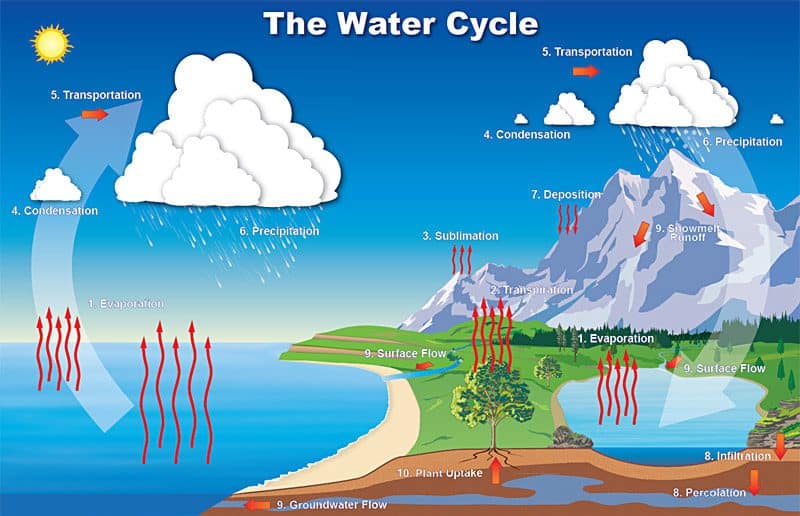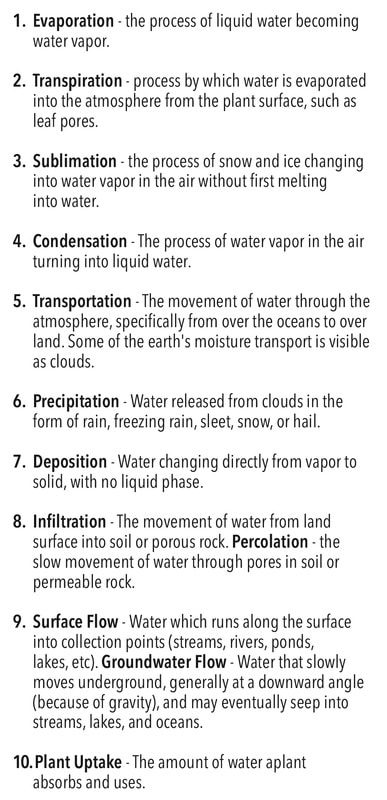Groundwater
What is Groundwater?
Most people in northern Michigan depend on groundwater as a source of clean drinking water. In rural areas, virtually everyone uses a well to provide water. Many municipalities use wells to get the water their residents use. Most people, however, don’t often think about how the water reaches their well, or about potential threats to the purity of their water.
The Water Cycle
- Water moves through the environment in a continuous cycle.
- Water evaporates from lakes, streams, the Great Lakes, and oceans.
- Water is also given off in large amounts by trees and other vegetation.
- This moisture returns to the earth as precipitation.
- As rain and snowmelt flow across the surface of the soil, some of the water flows into streams and lakes and becomes surface water.
- A large proportion of the water, however, seeps into the ground. Water that seeps below the surface is called groundwater.


The Water Table
Huge supplies of groundwater can be found under the surface throughout much of northern Michigan. Most groundwater is found in the pore spaces between soil or rock particles. Water seeping down from the soil surface fills these spaces. The downward flow of water is restricted by bedrock, or by dense soils such as clay or marl, which prevent the water from penetrating any deeper. When water saturates all the pore spaces in sand or gravel and the cracks in rocks, the formation is called an aquifer, which can yield large amounts of water to wells or springs. The upper surface of the zone of saturation is called the water table.
Groundwater Movement
Groundwater moves through soil, sometimes for very long distances. Groundwater flows downhill and can move slowly through soil toward lower elevations. Movement rates depend on the water table slope and soil pore space size. Water can move as slow as fractions of an inch per day in clay soils, or with larger particles, like sand and gravel, water can move many feet per day.
Groundwater Quality
Groundwater is an important resource because we need clean water to drink. Surface waters are easily contaminated by natural substances or pollution from human activities. Groundwater, on the other hand, is protected from some pollutants by the soil acting as a filter. Human activities can pose a serious threat to the groundwater because soil cannot filter out many of the pollutants we generate. If we protect our groundwater, we will have a readily available source of drinking water that we can count on to meet our needs.
Groundwater Contamination
Groundwater is vulnerable to many different kinds of contamination. In some areas, the groundwater is close to the surface, and many substances can move through the soil to reach the water table. Other contaminants dissolve in water, and can be transported through the soil as surface water seeps down toward the water table.
Many of the serious groundwater contamination problems in northern Michigan result from human activities:
- Agricultural use of fertilizers, pesticides, and animal wastes can contaminate groundwater.
- Rural household septic systems can cause contamination if not properly sited or maintained.
- Substances commonly used around the home, like cleaning products, automotive fluids, paints, and yard products can contaminate the groundwater if not disposed of properly.
- Storage tanks for gasoline and other fuels can leak, causing groundwater contamination.
- Old dump sites can cause contamination from a wide variety of materials disposed there. Small businesses may produce hazardous or toxic substances that must be very carefully handled to avoid groundwater contamination.
- If we take appropriate care to avoid these problems, we can avoid the serious consequences of groundwater contamination that are already occurring in other areas of the state.

